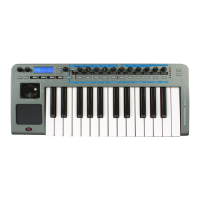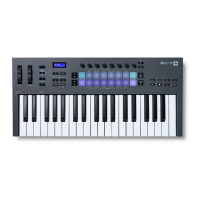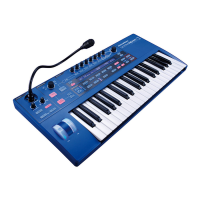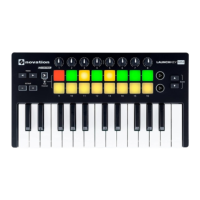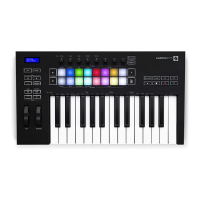Dual Mono Recording
If it is desired to record two different inputs
simultaneously - for example a guitar and
a vocal, repeat the setup process and set
the input gain for both the microphone and
the guitar independently. Use the INPUT
button to switch between each input to set
the signal level using the LED’s Begin
recording and use the BALANCE knob to
move the left to right position of either of
the two inputs. Within the sequencer set
one track to Input Channel 1 and the other
track to Input Channel 2.
Stereo Recording
Plug in a Stereo source (such as a CD player) and press the STEREO
button. Both input LED’s will light. Use the GAIN knob as previously
described to set the appropriate input level.
The BALANCE knob behaves in a different way when recording a
Stereo device. Rotating it fully anti-clockwise will result in the signal
being summed into a MONO signal. Rotating it fully clockwise will result
in a WIDE Stereo signal As in the previous examples the balance
between the previously recorded tracks and the new live stereo input
may be adjusted to suit by rotating the MONITOR input to output knob.
Recording And Listening With Effects
Most modern software audio sequencers allow the input signal to be
monitored with low latency but this is only a copy of whatever is
plugged into the audio input(s).
An outstanding feature of the X-Station is the ability to record and / or
monitor complete with effects, such as Reverb, without the need for an
external hardware effects box or without the need to engage additional
effects processors within the recording software.
This is particularly useful when recording vocals since the artist will nor-
mally prefer some amount of reverb in the headphones during a per-
formance. It usually will help him/her to envisage a live situation with
some ambience in the room.
There are three options with regard to monitoring and recording the
effects:
1. Bypass
This option will disable the effects section and the computer system will
record any audio data 'dry' - that is, an amplified version of the signal
appearing at the audio inputs. Any monitoring of the signal by head-
phones or on the main left and right outputs will also be 'dry'
2. Listen - Record
This option will enable the effects section and the computer system will
record any audio data 'wet' - that is, an amplified version of the signal
appearing at the audio inputs together with any of the audio effects
(such as reverb). Any monitoring of the signal by headphones or on the
main left and right outputs will also be 'wet'
3. Listen - No Record (Listen wet and Record Dry)
This option will enable the effects section BUT the computer will record
any audio data 'dry' - that is, an amplified version of the signal appear-
ing at the audio inputs. Any monitoring of the signal by headphones or
on the main left and right outputs will be 'wet'. This would be consid-
ered as a very useful option when, for example, recording a voice the
signal can be recorded 'dry' but the artist will be able to listen (monitor)
his or her performance with effects applied.
Adding Reverb
In the effects section press the UP/DOWN buttons to select the Reverb
effect - the corresponding LED will light. Adjust the LEVEL knob for the
desired amount of Reverb effect. The effects processors are powerful
multi effects type whereby one of each different effect may be applied
simultaneously if desired
See section ‘ Detailed Operation - The Dual Effects Processor’ on page
21 for more information on audio control and using the effects proces-
sor on recordings.
QUICK START GUIDE
Recording And Listening With Effects
• 11 •

